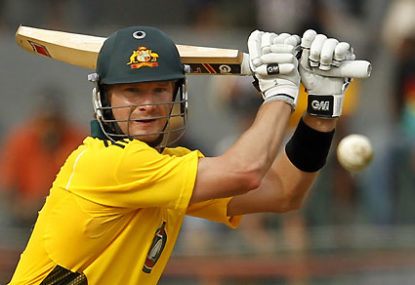WATCH: Stumps a mess as Rajasthan Royals opener gets ramp shot horribly wrong
Yashasvi Jaiswal was looking comfortable at 67 off 40, until this moment when he hit the ball into his own stumps!

Every code goes through a period where amendments must be made to the rules of the game, to prop up the curiosity factor or carry the game forward.
One-day international cricket, for instance, has been going through a series of minor alterations in rules ever since Twenty20 cricket burst onto the scene.
Meanwhile, debates rage on with regard to embracing technology in the world game, football.
To stay with cricket, why is it that the ball has to conform to rigid guidelines in terms of its size and weight and material used when there’s always more flexibility when it comes to the dimensions and weight of the bat?
As per the law, the weight of the bat can range from 1.1kg – 1.4kg and should not exceed 38 inches in length and 4.25 inches in width.
Now, with such a stretch, doesn’t this rule benefit the batsmen?
Moreover, it must be pointed out that the hand (or glove) is considered part of the bat.
The cricket bat has gone through significant changes ever since the game came into existence.
Around the 18th century, the first bat looked more like a hockey stick with the lack of standard dimensions at the time. Therefore, many batsmen opted for bats that shielded the stumps completely!
Later on, to overcome this, the size of the bat was limited to 4¼ inches and this proved a major advantage to batsmen since it led to the dawning of vertical and horizontal stroke play.
Subsequently, manufacturers used lighter willow to produce thinner yet heavier bats, thus resulting in the rise of finesse strokes such as the cut, the late-cut and the leg glance.
The late 1920s witnessed the arrival of heavier bats, used by illustrious batsmen such as Sir Don Bradman, Jack Hobbs and Bill Ponsford.
In the 1960s, Clive Lloyd and Graeme Pollock used bats weighing more than three pounds.
In the late 1970s, aluminium bats were used (by Dennis Lillee) but only for a brief period.
It was in the early 1980s that the ICC lent some regularity to the rule wherein: the cricket bat should only be made of wood.
Moving forward, to cash in on the entertainment quotient of Twenty20 cricket in the early 2000s, the bats manufactured came with a longer handle and an abridged yet meatier blade to boost stroke play.
In 2005, the bat with carbon-fibre-reinforced polymer support was produced but was immediately banned by the ICC as it favoured robust shot-making.
While the bat has changed beyond measure the ball, besides its colour, has remained uniform over the years.
This again supports the notion that cricket is truly a batsman’s game. The transformation of the bat also further mystifies the discussions that rumble on, whereby batsmen are compared from different eras.
The ICC could work towards making cricket a much more balanced affair between bat and ball.